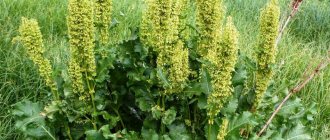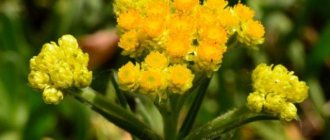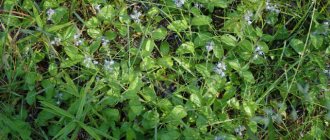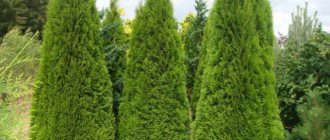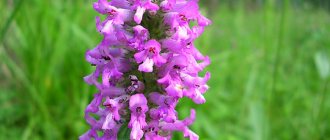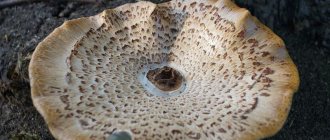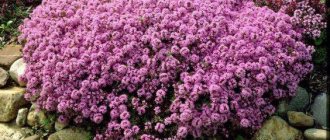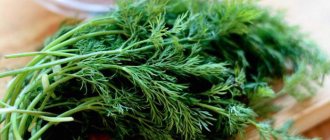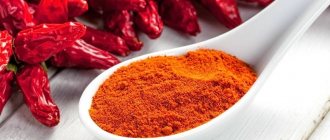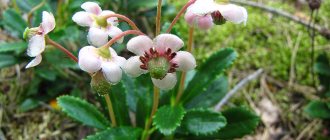Answer to the question
Let's start our review by confirming that thyme and thyme are the same thing . However, there are small nuances that we will talk about:
- Thyme has many varieties;
- The most common are ordinary and creeping;
- It is the last species, creeping thyme, that is thyme.
Thus, plants have identical characteristics and properties for humans - but in appearance they may differ. But we'll talk about this a little lower. The main conclusion that can be drawn is that thyme is thyme, or rather its variety. Let's give a detailed description of thyme.
Types of thyme
There are many types of shrubs - about 170. All grow on Russian lands, the name of the plant depends on them.
There is thyme:
- Dagestan;
- Ural;
- Kyrgyz;
- Baikal;
- Ukrainian and others.
Some types of shrubs are listed in the Red Book. The number of types is increasing, and new plants are being discovered. Today's research indicates the number is 214. Parts of the bush are used for cosmetic purposes and perfumery. In cooking, the dried plant serves as a seasoning. In pharmacology, common thyme and creeping thyme are used, which have similar properties.
Thymus
This is a woody subshrub belonging to the Lamiaceae family. Experts distinguish up to four hundred plant varieties that grow all over the world - in North Africa, Asia and Europe. It can grow in different climatic conditions, but most often takes root in temperate zones.
Main characteristics:
- The stems of the plant are branched;
- The maximum height of the bush is from 35 to 40 cm ;
- The stems can creep along the ground and rise upward;
- Inflorescences are groups of small flowers of white, purple, pink color;
- The leaves are hard, rich green, oval or round in shape;
- The flowering period occurs in the summer months;
- Fruit ripening - August or September;
- It bears fruit in a capsule, inside which a dark brown nut is hidden;
- Contains thymol, carvaclol.
We also recommend: Vitamins in carrots
The plant has become widespread in medicine, cooking, and landscape design. Beautiful bushes decorate the area in the best way and are easy to care for; their beneficial properties are useful in creating medicines. We’ll talk more about the benefits of the plant below.
Thus, when choosing between the names thyme or thyme, it is more appropriate to use the first - after all, both plants are just different varieties of the same species. Let's move on to the next description
Growing and caring for herbs in the garden
Growing thyme
Savory is unpretentious and is grown in almost all places. The conditions for its best growth are fertile soil and a sunny, well-warmed area.
Has high germination rate per 1 sq. per meter, about 300 g of seeds are consumed. Cold-resistant, can be sown under snow, and in the absence of snow, covering the area with seedlings to retain heat with a thick cloth. But mostly it is planted in the spring, when warm weather sets in.
Reproduction methods:
- seeds
- seedlings
- vegetatively
Seeds are planted in loosened, humus-fertilized and moist soil. They are sown in furrows no more than 1 cm deep, maintaining a distance between seeds of about 15 cm.
For better germination, the seeds are first kept in water for up to 1 day and additionally treated with a weak solution of potassium permanganate.
The seeds, dried on parchment paper until they flow, are lowered into the soil to a depth of 1 cm, the grooves are filled with sand, moistened, and covered with film. Shoots will appear on day 9-10; until this point, it is recommended to remove the dense fabric only to moisten the soil.
Seedlings are grown in the spring - from March to April; in late April - early May they are planted in open ground. Pre-winter sowing is carried out at the end of October.
Thyme care:
- weed removal
- rare soil moisture
- loosening the soil to a depth of 2-3 cm.
- periodic rejuvenation of woody bushes.
Growing thyme
In garden plots, thyme is grown in all its diversity of species. Compared to thyme, thyme is more capricious and does not tolerate shade or drafts.
The best soil fertilizers for planting thyme are wood ash and mineral additives. Common thyme is thermophilic and prefers bright light. The seeds are very small in size and are sown superficially. Favorable air temperature for seed growth is 20-30 degrees Celsius. They are first sown inside the greenhouse, and the resulting seedlings are planted in the ground.
Other types of thyme are less heat-loving; they are sown directly into the ground in the spring, or even in late autumn under the snow.
For seed growth, soil with high moisture content is required. The first shoots emerge after 3-4 weeks and develop slowly at first. Thyme species with creeping shoots easily reproduce by dividing the bush.
Thyme care:
- weeding
- loosening
- moderate watering.
Thyme
As we have already mentioned, thyme and thyme are different varieties of the same shrub. This is a beautiful plant that grows primarily in sandy soils throughout the world - most often in temperate countries, in forested and rocky areas.
Let us note the main characteristics of the flower:
- Shrub height – up to 15-20 cm ;
- The leaves are elliptical in shape and rich in essential oils. Size – up to 1 cm;
- Flowering lasts from May to September;
- The flowers are small, the inflorescences are grouped and have a pleasant lilac-violet hue;
- Flowering stems rise above the rest.
We have already decided that both names are given to the same subshrub. Let's look at whether savory and thyme are the same thing or not?
There cannot be two opinions on this issue - plants belong to the same family, but have a number of fundamental differences; they are completely different representatives of the flora. So, savory and thyme: what's the difference?
- Savory is not a perennial plant and only lives for a year;
- Savory has a distinct taste of black pepper and a different smell;
- Savory is rarely used in landscape design due to its difficult care.
We also recommend: How to store walnuts
We have already written about belonging to the family above. Let's finally figure out how thyme differs from thyme.
We advise you to read the article: Turmeric and saffron - the same thing or not.
If you want to grow thyme (thyme) at home, watch a training video on this topic:
About crop pests
Thyme is one of the most beautiful essential oil small shrubs.
Representative of the Lamiaceae family. The plant's closest relatives: mint, lemon balm, basil, sage. What is thyme? This is a perennial grass that spreads along the ground. Height is about 20-35 cm. Due to the fact that the plant has creeping stems, the height of thyme is only 10-15 cm. The color of the stems is brownish, you can see small hairs. The stems are very thin, but elastic and dense. There are many branches on them. Closer to the base, the stems are stiff. Creeping along the soil, in the most fertile places the stems take root, sending out roots.
Thyme
The root system of the crop has a rod-like appearance, with branches. The root is woody and strong.
The leaves are shaped like an oval, an egg. Slightly concave inward. They are small - about 0.5 cm. Depending on the type, the leaves are smooth, jagged, with or without veins. The upper part of the leaf is emerald green. The color of the lower part is gray-green. The petiole is short and almost invisible.
The flowers are small. Depending on the varieties, the color of the petals is whitish, purple, lilac, or fiery. The inflorescence is located above the bush. It stretches towards the sky on a straight shoot. In September the thyme fruits ripen. They are located in dark nuts hidden in boxes.
Additional Information. The peculiarity of the culture is long flowering. Thyme grass blooms in mid-June. It blooms only in August. It has a spicy, fragrant, light aroma.
Thyme has another name - thyme. The emphasis is on the second syllable. The question “how to write correctly: thyme or thyme?” has a clear answer. Both options are allowed. The question also has a positive answer: is thyme or thyme the same thing?
What is another name for thyme? Thyme has another name - creeping thyme, Bogorodskaya shrub, Bogorodskaya herb.
The thyme plant has medicinal properties. It can be grown to eliminate health problems. Thyme has diverse properties. Let's try to figure out what properties thyme has.
Thus, healing thyme helps with various pains. It is brewed if you have a headache, stomachache, or cramps. Oil from the plant can be used if the menstrual cycle is disrupted, as well as during menopause.
The culture can treat wounds of various origins, as it is a powerful antiseptic.
Antiseptic
Another property of the culture is antibacterial. Thanks to him, medicinal thyme fights acne.
Thyme herb is used in the preparation of healing mixtures. A collection of plantain, thyme, and chamomile will help with bronchial asthma, laryngitis, and bronchitis.
It is recommended to drink tea with thyme to treat impotence and inflammation of the prostate gland. If a man suffers from premature ejaculation, it is recommended to use oil prepared with creeping thyme. It's easy to do. The plant is dried and crushed. Take 20-30 grams of dry mixture.
Tea with thyme
What other benefits does thyme have? Thyme oil is used to remove stretch marks after pregnancy; tea with this plant will help increase lactation.
A medicinal mixture of spicy herbs helps treat alcoholism. In this case, relatives may try to cure the patient without his knowledge. It often happens that a person simply does not want to give up alcohol. This causes problems for his family. In this case, thyme will come to the rescue. The plant contains thymol.
Thyme decoction is used as a relaxant. A bath with a decoction will help cope with fatigue and moisturize the skin. You can rinse your hair with the decoction. This procedure will make your hair stronger and get rid of dandruff.
Another popular remedy is creeping thyme tincture. Fresh twigs with flowers are placed in a 0.5 liter container. The jar or bottle should be half filled with them. Next, 0.4 liters of vodka are poured there. The tincture should not be touched for 2 weeks. After this, she rubs the joints that ache. Muscle pain will go away.
Important! The benefit of thyme is to increase immunity. It protects the body from the influence of negative environmental factors, various viruses, and diseases.
Pharmacognosy considers medicinal thyme very carefully, due to the fact that this herb is an important source of raw materials for medicines. Thus, creeping thyme extract is one of the elements of the popular remedy - Pertussin. This drug is prescribed to patients who suffer from cough.
Essential oils, tinctures are produced from the plant, and are released as part of medicinal preparations. In pharmacies and specialized retail outlets you can see dry thyme. Thyme is included as a herbal component in various painkillers and medications intended for the gastrointestinal tract. It is added to elixirs that improve health. The essential oil from the plant is used in the production of ointments and creams.
Planting creeping thyme in the garden is not only beautiful, but also practical. Due to its fragrant aroma, it repels pests. Moreover, not only from their own bushes, but also from crops that are their closest neighbors. But this requires proper care of the herb. If there is none, then pests will appear.
Weevil
Thyme can be attacked by aphids, weevils, and meadow moths. If the owner of the site notices these insects on the crop, it is necessary to take immediate action. You need to fight it with chemicals that are harmless to humans.
Thyme can be called a real miracle of nature. Its healing properties were discovered about three centuries ago. The grass was revered by our ancestors. And in the modern world, thyme is included in many medicines. You can plant herbs in your garden and use them as a seasoning or for healing. However, moderation should be observed.
Differences
Despite the fact that both names appear to belong to the same plant, there are some differences in appearance that will confuse the inexperienced gardener.
Thyme and thyme - what's the difference:
- Thyme is characterized by less splendor and brightness of inflorescences;
- Its stems are thicker and its root system is wider;
- Unlike thyme, it grows on rocky soil and in the steppe, and only occasionally in clearings in the forest.
We remind you that all properties and effects on humans remain identical - the differences between thyme and thyme lie only in appearance.
Collection and preparation of plants
The thyme is harvested before or at the very beginning of its flowering. Later the leaves become bitter. The plants are cut to the base of the stem, leaving the stem about 15 cm from the ground. The cut stems with leaves and flowers are divided into small bunches and tied.
The finished bundles are hung to dry. Can be dried without tying them in bunches. A prerequisite for drying is a dark, ventilated room. Dried savory is stored in a dark, dry place.
The thyme harvest is collected during its flowering by cutting off the tops with inflorescences. The cut crop is dried on a cloth without direct sunlight and crushed. At the end of flowering, fruits are formed. July-August is the time to harvest thyme.
Application
The plant is used in many areas:
- Cooking. The herb is actively used in food as a spice - for meat and fish dishes, especially game, it will complement soups, marinades and pickles, and will be an excellent addition to salads;
- Medicine. The medicinal properties allow the plant to be used as a component of ointments for various purposes; tea with thyme is also very useful;
- Cosmetology. Essential oils help smooth the skin, get rid of wrinkles, improve the condition of nails and hair;
- Design. Elegant shrubs can enhance any area.
What can you replace savory with?
Mint and clove essential oil have a similar healing effect. In cooking, thyme is replaced with a mixture of Italian herbs and oregano. Of course, the taste of the dish will be different, but general notes in the aroma will still appear. Thyme is often present in second courses and soups in Mediterranean cuisine; in Russia, the herb is popular as a medicinal remedy and an additive to tea.
A burning taste and bitterness will be created by mixtures with cloves, cumin, cumin, and bay leaves. You can replace citron in meat dishes with the seasoning hop-suneli with fenugreek; the herb is included in the mixture of Provencal herbs. To prepare fish, savory is replaced with rosemary in combination with black pepper.
Beneficial features
We told you how thyme differs from thyme and how they are similar. Another huge similarity lies in the beneficial properties - they are absolutely identical.
We also recommend: Congee
Here are the parameters included in this list:
- Suitable for hypotensive patients, as it increases blood pressure;
- During pregnancy, it helps improve the tone of the uterus;
- Treats diseases of the nervous system;
- Good for eliminating gynecological diseases and problems with the genitourinary system in men;
- It has a great effect on the nervous system - calms, improves mood, reduces stress and improves sleep quality;
- Used for nicotine and alcohol addiction;
- Used to treat skin diseases;
- Improves the quality of life of diabetics;
- Speeds up metabolism and relieves swelling, along with excess weight; cumin is also good for this;
- Has an analgesic effect;
- Improves immunity, has antiviral and antimicrobial effects;
- Used as an antiseptic;
- Treats respiratory diseases, used for coughs.
The beneficial properties are due to the rich content of the following vitamins:
- Groups A, B, C, E, K;
- Folic acid;
- Beta carotene.
Chemical composition
Thyme properties and uses are determined by its rich chemical composition. The plant contains:
- Vitamins of group B, C, E, K, A, PP;
- Carotene;
- Potassium;
- Calcium;
- Selenium;
- Iron;
- Sodium;
- Thymol;
- Carvacrol;
- Terpineol;
- Borneol;
- Caryophyllene;
- Ursolic acid.
If everything is clear with vitamins, macroelements, microelements, then other names of the substances contained in the grass may alarm the average person. However, each of these components is a very necessary element.
Thymol is a monoterpene phenol. It is a natural antiseptic. This substance has an anti-inflammatory, analgesic effect.
Carvacrol is an organic compound, a natural antibiotic. Its action extends to viruses and microbes of various types.
Terpineol is an isomer. Has a strong antimicrobial effect.
Borneol is a terpene alcohol. It is non-toxic. This chemical compound is an antiseptic. It copes with diseases of the gastrointestinal tract, infections, heals, and rejuvenates the skin.
Caryophyllene is a hydrocarbon responsible for improving skin.
Interesting. The essential oil that is part of thyme consists of thymol and caryophyllene.
Ursolic acid has an anti-inflammatory effect and has a positive effect on the functioning of all organs in the human body.
Each chemical element has its own specificity and is responsible for a certain property. However, it is the complex of substances that allows thyme to have such strong healing capabilities.
Contraindications
Let's finally note the contraindications that each medicinal plant has. You should not eat it if you have:
- Gastrointestinal diseases;
- Liver and kidney diseases;
- Diseases of the heart and vascular system;
- Allergic reactions.
Excessive consumption may cause the following side effects:
- Nausea;
- Dizziness and headache;
- Sudden jumps in blood pressure.
That's all, now you know everything about the two herbs and, if necessary, you can safely say that common thyme and thyme are not the same thing, but the creeping variety has two names at once. Use the plant correctly, use in limited quantities and only for its intended purpose.
About crop pests
Such a unique chemical composition can not only help, but also cause harm. This plant should not be consumed if a person has a stomach ulcer, problems with the kidneys or liver. Another contraindication to the use of thyme is insufficient functioning of the thyroid gland. You should not use creeping thyme if you have a myocardial infarction or pregnancy.
Note! For the plant to be beneficial, its use must be moderate. Otherwise, the person may experience an attack of nausea.
Weevil
